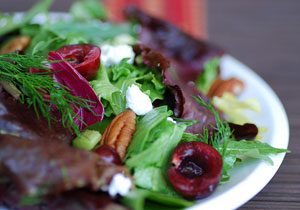 For the last couple of weeks, I have been unusually happy. It's not the weather or exercise or Prozac. It's cherries. Here's the deal with cherries: their season is ridiculously short, their price is ridiculously high, but the flavor is ridiculously delicious. Who can deny the pure pleasure of eating a sweet-tart, fresh, juicy cherry? It is prime cherry pickin' time. So here's what you need to know about selecting, storing, and cooking with cherries.
For the last couple of weeks, I have been unusually happy. It's not the weather or exercise or Prozac. It's cherries. Here's the deal with cherries: their season is ridiculously short, their price is ridiculously high, but the flavor is ridiculously delicious. Who can deny the pure pleasure of eating a sweet-tart, fresh, juicy cherry? It is prime cherry pickin' time. So here's what you need to know about selecting, storing, and cooking with cherries.When is cherry season?
Most cherries are in season from late May through late July. The season is short: typically 4-5 weeks, peaking at about week 3.
Why are cherries so expensive?
For good reasons: Cherries are highly dependent upon good weather; they're also highly susceptible to insect damage and disease and often require protection from netting or cheesecloth, which is time consuming for farm workers. Finally, they must be picked carefully and are highly perishable since they do not ripen once harvested. This all adds up to a labor intensive and expensive fruit to produce, which is why the price is high. Don't wait for a big sale on cherries; it might not come. If you love them – and you know you do – then just splurge.
How do you select cherries?
Ripe cherries should be firm, but not hard. The color can range from scarlet to burgundy depending on the variety. In general look for deeply saturated cherries. Discard any cherries that are split, knicked or bruised.
How do you store cherries?
Store cherries unwashed in a covered plastic container in the refrigerator. They should last 4-5 days. To freeze cherries, wash and thoroughly dry the pitted or unpitted cherries; store loosely in resealable freezer bags. Defrost when ready to use. Frozen cherries will last up to 6 months in the freezer.
 How do you pit a cherry?
How do you pit a cherry?
You can buy a cherry pitter. Or you can do it the old-fashioned way, like me: Place the cherry on a cutting board. Place the flat side of a wide knife on the cherry and press gently until it splits. Open the cherry and remove the pit.
How do you eat cherries?
In the car on the way home from the market. Come on, you know you do. But if you have the will power, then wait until you get home to give them a rinse under some running water. Then eat to your heart's content. Cherries are ideal in sweet dishes, such as pies, clafoutis, cobblers, cakes, and ice cream. They also work well in many savory dishes. Try them in salads, chutneys, and sauces, which are wonderful on chicken, duck, and pork.
Mesclun, Cherry, and Goat Cheese Salad
Serves 4
Vinaigrette:
1 tablespoon extra virgin olive oil
2 tablespoons white balsamic vinegar
1 teaspoon lemon juice
2 tablespoons finely chopped fresh mint or parsley
1/4 teaspoon sugar
salt and freshly ground black pepper, to taste
Salad:
8 cups mesclun greens, preferably with mixed herbs
1 cup pitted fresh cherries, halved
2 inner white stalks of celery with leaves, thinly sliced
2 tablespoons crumbled goat cheese
2 tablespoons toasted pecans
For the vinaigrette, whisk all ingredients in a small bowl and set aside.
In a large bowl, add the mesclun greens, cherries, and celery. Pour half of the vinaigrette and toss until coated. Divide evenly among four plates. Add crumbled goat cheese and pecans to each plate. Drizzle with the remaining vinaigrette.
**White balsamic vinegar is made from white wine vinegar and grapes. Because it is milder than traditional brown balsamic vinegar and doesn't stain food, it's preferable for this cherry salad. It can be found at specialty markets and most major supermarkets. Rice vinegar can be substituted.
Susan Russo is a free lance food writer in San Diego, California. She publishes stories, recipes, and photos on her cooking blog, <Food Blogga and is a regular contributor to NPR’s <Kitchen Window. She is also the author of Recipes Every Man Should Know and The Encyclopedia of Sandwiches
.

